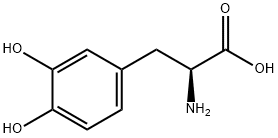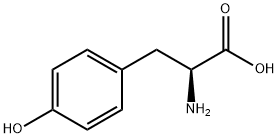L-dopa , 99% , 59-92-7
Synonym(s):
L -3-Hydroxytyrosine;L -DOPA;3-(3,4-Dihydroxyphenyl)-L -alanine;3,4-Dihydroxy-L- phenylalanine;Levodopa
CAS NO.:59-92-7
Empirical Formula: C9H11NO4
Molecular Weight: 197.19
MDL number: MFCD00002598
EINECS: 200-445-2
| Pack Size | Price | Stock | Quantity |
| 25G | RMB55.20 | In Stock |
|
| 100G | RMB119.20 | In Stock |
|
| 500G | RMB559.20 | In Stock |
|
| others | Enquire |
PRODUCT Properties
| Melting point: | 276-278 °C (lit.) |
| Boiling point: | 334.28°C (rough estimate) |
| alpha | -11.7 º (c=5.3, 1N HCl) |
| Density | 1.3075 (rough estimate) |
| refractive index | -12 ° (C=5, 1mol/L HCl) |
| storage temp. | 2-8°C |
| solubility | Slightly soluble in water, practically insoluble in ethanol (96 per cent). It is freely soluble in 1 M hydrochloric acid and sparingly soluble in 0.1 M hydrochloric acid . |
| pka | 2.32(at 25℃) |
| form | Crystalline Powder |
| color | White to creamy |
| Odor | at 100.00 %. odorless |
| Odor Type | odorless |
| optical activity | -39.5 (H2O) -12.025 (1 mol dm-3 HCl) |
| Water Solubility | Slightly soluble in water, dilute hydrochloric acid and formic acid. Insoluble in ethanol. |
| Merck | 14,5464 |
| BRN | 2215169 |
| Stability: | Stable. Incompatible with strong oxidizing agents. Light and air sensitive. |
| InChIKey | WTDRDQBEARUVNC-LURJTMIESA-N |
| LogP | -1.154 (est) |
| CAS DataBase Reference | 59-92-7(CAS DataBase Reference) |
| NIST Chemistry Reference | Levodopa(59-92-7) |
| EPA Substance Registry System | Levodopa (59-92-7) |
Description and Uses
Levodopa is an amino acid precursor of dopamine with antiparkinsonian properties. Levodopa is a prodrug that is converted to dopamine by DOPA decarboxylase and can cross the blood-brain barrier. When in the brain, levodopa is decarboxylated to dopamine and stimulates the dopaminergic receptors, thereby compensating for the depleted supply of endogenous dopamine seen in Parkinson's disease. To assure that adequate concentrations of levodopa reach the central nervous system, it is administered with carbidopa, a decarboxylase inhibitor that does not cross the blood-brain barrier, thereby diminishing the decarboxylation and inactivation of levodopa in peripheral tissues and increasing the delivery of dopamine to the CNS.
Levodopa is an immediate precursor of dopamine and product of tyrosine hydroxylase. It derived from vanillin is widely used for treatment of Parkinson’s disease, most often in combination with peripheral decarboxylase inhibitors such as benserazide and carbidopa.
Safety
| Symbol(GHS) |  GHS07 |
| Signal word | Warning |
| Hazard statements | H302-H315-H319-H335 |
| Precautionary statements | P261-P264-P270-P301+P312-P302+P352-P305+P351+P338 |
| Hazard Codes | Xn |
| Risk Statements | 22-36/37/38-20/21/22 |
| Safety Statements | 26-36-24/25 |
| WGK Germany | 3 |
| RTECS | AY5600000 |
| F | 10-23 |
| TSCA | Yes |
| HS Code | 29225090 |
| Hazardous Substances Data | 59-92-7(Hazardous Substances Data) |
| Toxicity | LD50 in mice (mg/kg): 3650 ±327 orally, 1140 ±66 i.p., 450 ±42 i.v., >400 s.c.; in male, female rats (mg/kg): >3000, >3000 orally; 624, 663 i.p.; >1500, >1500 s.c. (Clark) |




